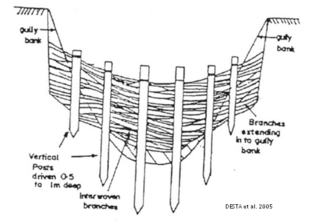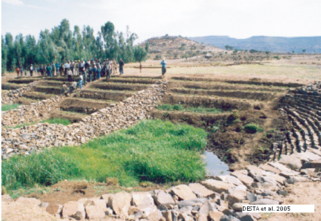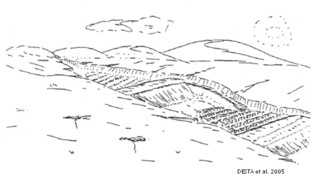BIOPHYSICAL MEASURES[1]
|
|
Gully control[1]
|
Stone Checkdams
- Objectives: A stone checkdam is a structure across the bottom of a gully or a small stream, which reduces the velocity of runoff and prevents the deepening and widening of the gully. Sediments accumulated behind a checkdam could be planted with crops or trees/shrubs grass and thus provide additional income to the farmer.
Brushwood Checkdams
- Objectives: Brushwood checkdams are vegetative measures constructed with vegetative materials, branches, poles/posts and twigs. Plant species which can easily grow vegetatively through shoot cuttings are ideal for this purpose. The objective of BWs is to retain sediments and slowdown runoff, and enhance the revegetation of gully areas. They are constructed either in single or double row. Some of the vegetation can be used for fodder. BWs are also ideal to stabilize conservation structures bunds, SS bunds, check dams, bench terraces, road sides, etc.
Gully Reshaping, Filling and Revegetation
- Objectives: Reshaping & Filling is an operation meant to decrease the gully erosion angle of incidence, create planting areas and encourage revegetation & stabilization, usually in small gullies or in other medium sized gullies from which most runoff has been diverted into a stable waterway or drainage line. When these gullies are shaped and smoothed, vegetation can be established over the levelled gullies. Some of these areas can be used for farming purposes. Revegetation of a gully is the plantation of the reshaped gully sides and bottom with multipurpose species so that it reduces runoff and control erosion and make the land productive. Gully revegetation implies reaching a dense vegetation cover over the entire gully surface, i.e. both sides and bottom by planting grasses, legumes and a variety of trees and shrubs.
Sediment Storage and Overflow Earth Dams (SS Dams) for Productive Gully Control
- Objectives: SS dams are water harvesting and conservation systems that convert unproductive large and active gullies into productive areas (fertile cultivated or fodder producing areas, mixed plantations, and fruit tree orchards). SS dams are stone-faced earth dams constructed across medium/large size gullies to trap sediments, collect water and divert excess runoff. SS dams accommodate the runoff generated by the catchment located above the gully. The structures are often constructed in series along the gully. It is just like creating a land that does not exist. Contribute significantly to protect cultivated lands, arrest gully expansion and recharge water tables. Huge potential in Ethiopia - can provide tens of thousand Km of gullies to poor households (small land holders and landless).
Sediment Storage and Overflow Soil Bunds (SS Bunds)
- Objectives: SS bunds are large and strongly built soil embankments, constructed across gullies, often in series. As for SS dams, their purpose is to create a new field for cultivation by allowing and helping the sedimentation (filling) of the space behind each bund. After rains, the new fields fill up and retain enough soil and moisture to grow crops. The excess runoff move to the next structure downstream through a spillway.
|
Agro-forestry, Forage Development and Forestry[1]
|
Area Closure
- Objectives: Strip cropping is a cropping practice where strips of two or more crops are alternately established on the contour or, it is a system of establishing more than one crop in alternate strips following a contour pattern for the purpose of erosion control, crop diversification, and decrease the risks associated to the use of single crops only. This cropping system is designed as a defence mechanism against soil erosion in areas where the cropping system is dominated by row/sparsely growing crops that exposes the ground to erosive forces. For instance, crops like sorghum and maize are susceptible to erosion and need to be grown alternately with soil conserving crops.

Microbasins (MBs)
- Objectives: MBs are small circular & stone faced (occasionally sodded) structures for tree planting. Are suitable for medium and slightly low rainfall areas, stony areas and shallow soils. Based upon experience they are not very effective in low rainfall areas (where trenches, eyebrows, etc. are preferred).

Eyebrow Basins (EBs)
- Objectives: EB are larger circular and stone faced (occasionally sodded) structures for tree and other species planting. Based upon experience they are effective in low rainfall areas to grow trees and harvest moisture. Can be constructed in slopes above 50% for spot planting. Controls runoff and contribute to recharge of water tables.
Herring bones (HBs)
- Objectives: HBs are small trapezoidal structures (called also A structures) for tree and other species planting. HBs are suitable for both dry and medium rainfall areas, and medium soil depth. Based upon experience HBs are most effective in medium/low rainfall areas (500-900 mm). Can be constructed only on slopes < 5% and soils > 50 cm depth
Micro-trenches (MTRs)
- Objectives: MTRs are rectangular and deep pits constructed along the contours - main purpose and effects are same as for trenches. Can support the growth of trees, shrubs, and cash
crops. Can be constructed on slopes 3-30% max. gradient and soils at least 50 cm depth.
Trenches
- Objectives: Trenches are large and deep pits constructed along the contours with the main purpose of collecting & storing rainfall water to support the growth of trees, shrubs, cash crops and grass or various combination of those species in moisture stressed areas (350-900 mm rainfall). Trenches can have FLEXIBLE DESIGN, to accommodate the requirements of different species. Therefore they can suit what the farmer want to grow. Trenches collect and store considerable amount of runoff water, thus vegetation grows faster and vigorous. Trenches protect cultivated fields located downstream from flood and erosion. Part of the water captured by the trenches reaches the underground aquifer. Therefore, water tables are recharged and supply springs and wells with good quality water and for a long period of time.
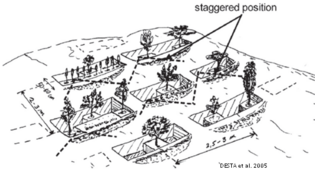
Improved Pits (IP)
- Objectives: IPs are square shaped water collection pits constructed along the contours with a plantation pit in front of the main water storage pit - main purpose similar as micro-trenches. IP support the growth of trees and fodder shrubs, and can be used for cash crops like coffee. They are effective in medium and low-medium rainfall areas (above 600-700 mm).
Multistorey Gardening
- Objectives: Multi-storey gardening is a way of planting a mixture of crops, shrubs and trees of different heights and different uses: food crops, cash crops, fruit trees, woody perennials, and forage plants. It makes the land more productive and improves soil fertility, reduces temperature, provides shade, and increase family income, particularly during a period of drought.Fields close or within homesteads can be converted into diversified productive units (decreasing risk factors, increased income, etc.). Such systems have higher resistance to pests and insects. A broad network of such homesteads can extend into open fields and constitute large erosion-protected zones or a “web” of green fences and mutually supporting units.

Seed Collection
- Objectives: Seed collection is divided into two:(1) Seed collection of tree species: mostly for indigenous trees to grow in nurseries for specific and multipurpose uses. (2) Legume shrubs and grass seeds: mainly legume shrubs seeds and grass/plant species that can be used for stabilisation, homestead plantations, grazing lands improvement, support to nurseries, fencing, gully control. This activity is especially valuable for grass seeds collected outside the nursery areas and seed multiplication centers, particularly native grasses of particular value for their palatability and adaptation to local conditions. The collection of local seeds is an effective way to protect valuable planting materials from extinction and to replenish depleted areas with materials collected from other areas.
|
Soil Fertility Management and Biological Soil Conservation[1]
|
Compost Making
- Objectives: To promote compost making at household level for cost-effective soil fertility improvement
and to support local level compost entrepreneurship linked to natural resources management activities at watershed level. CM will improve soil fertility, increase water storage within the soil profile and reduce surface runoff, thus reduce soil erosion. It is one of the best “hidden” water harvesting methods available (compost absorbs water 4-7 times its own weight). CM can be undertaken at very large scale and linked to area closure management and the upgrading of terraces into “cash crop production belts”. CM can become a business: groups of households (landless, etc.) can decide to become compost makers and provide “fertilization” services to other farmers.
Fertilization and Manuring
- Objectives: The current cropping systems in Ethiopia are highly extractive as chemical fertilizers are expensive and not always available, manure is used in most areas as fuel or income source, due to open grazing manure not readily available as compared to tethered animals, mulching is not practiced due to use of crop residues for forage. Levels of organic matter are low leading to reduced soil stability, infiltration, water holding capacity and increasing erosion. Application of fertilizers will increase yields, while manure and mulching will improve longterm soil quality and nutrient levels.
Live Checkdams
- Objectives: Live check-dams are established by planting/seeding or plugging of cuttings in gully bottoms to replace or reinforce physical check-dams. The main objective of the establishment of live check-dams is to reduce the cost of establishing physical check-dams. Live check-dams can be applied by individual farmers and does not need the organization of a large group of people to undertake physical structures.
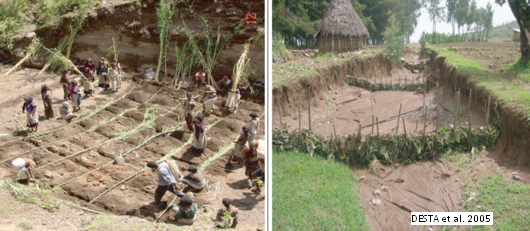
Mulching and Crop Residues Management
- Objectives: Mulching is the covering of the soil with crop residues such as straws, maize/sorghum
stalks or standing stubble. The cover protects the soil from raindrops, drastically reduces splash erosion and velocity of runoff. It then minimises erosion, increases soil infiltration and permeability, prevents the formation of hard crusts and contribute to improve fertility. The second major advantage of mulching/crop residue maintenance, is its potential for sustaining productivity. Mulching, in addition to its positive effects on soil structure also helps in reducing evaporation and maintaining soil moisture. The improved soil structure also will have an effect on moisture retention and consequently higher water budgets for the growing crop.
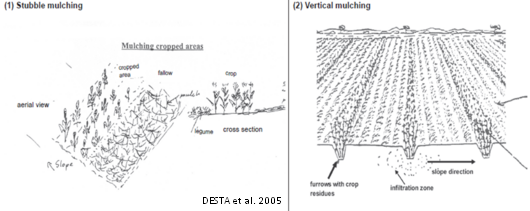
Grass Strips along the Contours
- Objectives: Grass strips are vegetative barriers made out of grass planted in narrow strips of 0.5 to 1.5 m width laid out along the contour. Grass strips control erosion rather effectively in gentle slopes but above 5-8% slope their effect decreases. While contributing to protect soils against erosion they also provide valuable biomass meant to increase animal feed or used for different purposes (eg. roofing, etc.). Grass strips cause less interference than other measures as they can easily be crossed by oxen and plough. Moreover, grass strips take out little amount of arable land. Cost of construction is much lower than physical structures.
Stabilization of physical Structures and Farm Boundaries
- Objectives: Stabilization refers to the planting of crops, grass, shrubs and trees in different combinations
in order to strengthen the resistance and stability of physical structures such as bunds, trenches, checkdams, SS dams, etc, against rain drops splash effect, runoff and cattle trampling. At the same time, stabilization has the purpose of making productive the surface area occupied by the structure. Stabilized structures would need less maintenance and damages are less likely to occur, even during heavy rainstorms. Trees or shrubs help to demarcate farm and homestead boundaries, thus provide additional sense of ownership. Particular plants are also hosts for insects able to control pest incidence. Stabilized areas are an additional source of timber, fuelwood, fibre, food and forage, palatable grasses and legumes, fruits and other products (dyes, gum, medicinal, etc.).
Vegetative Fencing
- Objectives: Vegetative fencing (VF) is a conservation practice which consist of a combination of vegetative planting materials resistant to cattle grazing planted in rows and with grass/legume plant species sowed behind these rows. Used to protect and enrich reclaimed areas like closures and gullies, farm boundaries and specific community assets like ponds. By doing so it also helps controlling runoff and erosion. It is the “first level of defence” against animal interference that allow other valuable trees to be planted after the fence is established. VF can be exercised as a “grid system” in closures, around reclaimed gullies, and farms, providing increased sense of ownership to users.
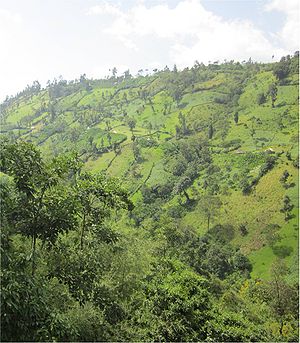 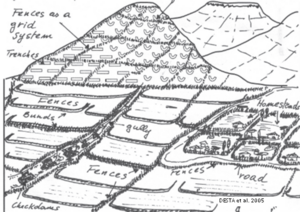
Ley Cropping
- Objectives: Ley cropping is a cropping system in which legume based pastures are rotated with purely
grown crops. Legume based pastures are grown on fallow lands for a few years to improve fertility of the soil and thus the yields of subsequent crops (mainly cereals). The establishment of dense, productive forage crops during the fallow period (1-3 years) provides a thick ground cover, supply forage of good quality after the rainy season, prevent soil erosion, restore soil fertility quicker than bare (and overgrazed) fallow, increase the water holding capacity of the soil and have a beneficial effect on future crop yields.
Integration of Food/Feed Legumes into Cereal Cropping Systems
- Better and full use of production resources such as water, radiation, nutrients, space and time.
- Integration of cropping optimises productivity by producing higher combined yields from the crops and greater economic returns from a given area of land than the same crop grown in monoculture.
- Lower risk in intercropping than with mono cropping.
- Better distribution pattern of labour demand. For example, land preparation is done only once for all crops and therefore the labour situation is less constrained.
- Control pests, diseases and weeds in the absence of biocides.
- Better control of soil erosion realised.
Intercropping
- Objectives: Intercropping is a practice of growing two or more crops along the contour simultaneously in the same plot in a fixed pattern in one season. The aim of intercropping is to increase crop production and provide protection to the soil against erosive forces. Different planting times and different length of growing periods spreads the labour requirement of planting and harvesting, but also allows midseason change of plan according to the rain in the early part of the season. The various leaf arrangements of different plants allow light to be better intercepted over time. The contrasting patterns of root growth, which utilize different soil layers, optimize the use of available soil moisture and nutrients. Mixed stands protect the soil surface more effectively than pure stands. Overall output per unit area can be much greater from intercrops than single crops and chances of total crop losses are lower than in pure stands.
Crop Rotation
- Objectives: Crop rotation is one of the oldest practices known to man for fertility restoration and pest/ disease control and it consists of growing different crops one after the other on the same piece
of land. Plants of the same crop develop their roots at the same depth of soil profile and thus the proliferation of the root systems in the same depth results in a strong competition for moisture and nutrients. Therefore, if the same crop is grown on the same land year after year, the soil nutrient in that layer decreases sharply and the crop yield consequently declines. On the other hand, if different crops are rotated, the depletion of soil nutrients and decline of crop yields are not as serious as when the same crop is grown year after year. Different crops have different characteristics that enable them to exploit the soil at different depths. Crops also differ in terms of their effect to the soil. Some crops restore or build fertility while others deplete fertility.
Strip Cropping
- Objectives: Strip cropping is a cropping practice where strips of two or more crops are alternately established on the contour or, it is a system of establishing more than one crop in alternate strips following a contour pattern for the purpose of erosion control, crop diversification, and decrease the risks associated to the use of single crops only. This cropping system is designed as a defence mechanism against soil erosion in areas where the cropping system is dominated by row/sparsely growing crops that exposes the ground to erosive forces. For instance, crops like sorghum and maize are susceptible to erosion and need to be grown alternately with soil conserving crops.
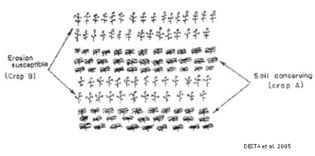
|
Flood Control and Improved Drainage[1]
|
Waterways (Vegetative and Stone Paved)
- Objectives: A waterway is a natural or artificial drainage channel constructed along the steepest
slope or in a valley to receive/accommodate runoff from cut-off drains and graded terraces/bunds. The waterway carries the run-off to rivers, resevoirs or gullies safely without creating erosion. A vegetative waterway can be constructed in areas without stones. The main advantage is that waterways can be constructed for both very small and large size catchments, thus accomodating individual or communal needs for drainage and evacuation/use of excess run-off. Paved waterways are suitable in steeper terrains and areas with large amount of stones.

Cut-off Drains
- Objectives: A cut-off drain is a graded channel constructed to intercept and divert the surface runoff from higher ground/slopes and protect downstream cultivated land or village. This safely divert the run-off to a waterway, river, gully, etc. In the dry lands, cut-off drains may be used mainly for the following purposes:
- Divert additional water to cultivated plots;
- Divert additional water to SS dams and croped areas inside gullies;
- Divert additional water into reservoirs for irrigation and/or domestic use.
Graded Soil Bund
- Objectives: Graded soil bund is similar in description with level soil bund. However, graded soil bund is upto a maximum of 1% inclined against the contour so that excess runoff is allowed to drain to the adjoining natural or artificial waterways. It is also possible and necessary to inculde tied ridges smaller in height within the channel of the terrace. The stored water within the ties can infiltrate into the soil while any above that height is drained out. Graded soil bunds can be made to gradually develop in to benched type terraces through careful maintenace. Any integration of other measures such as stabilization and composting can be applied as it can be applied on level bunds.
Graded Fanya Juu
- Objectives: The GFJ with a maximum gradient of 1% dishcarges excess runoff generated from the inter terrace spaces to the adjoining natural or artificial waterway at a non-erosive velociy. This consequently reduces runoff and soil erosion. It is also possible to inculde tied ridges smaller in height within the channel of the terrace. The stored water within the ties can infiltrate into the soil while any excess above that height is drained out. Graded fanya juu bunds can be made to gradually develop in to benched type terraces through maintenace.
Improved Surface Drainage for Increasing Productivity of Vertisols and Soils with Vertic Properties
- Increased aeration of the soil.
- Improved soil workability.
- Earlier sowing date.
- Higher and more diversified crop production, possibly double cropping.
- Decrease in (peak) runoff flow.
- Soil erosion decreased due to early vegetative cover.
- Increased crop and residue yields.
- Early harvest when there is shortage of food supply and also help farmers benefit from higher prices.
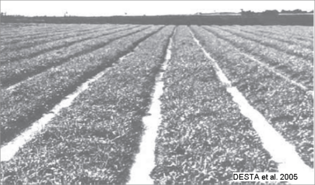
|
Physical Soil and Water Conservation[1]
|
Level Soil Bunds
- Objectives: The bund reduces and stops the velocity of runoff and consequently reduces soil erosion and the steady decline of crop yields. They are impermeable structures, unless provided with spillways, intended to retain all rainfall, and hence, increase the moisture retention capacity of the soil profile and water availability to plants, and increase the efficiency of fertilizer applications if any. Through their water retention effect, the bunds may allow some crop yield even in drought years. Soil bunds are entry points for further stabilisation and application of organic residues or compost (especially if applied in the first meters behind the bund where soil is deeper).
Stone Bunds
- Objectives: The stone bund reduces and stops the velocity of runoff and consequently reduces soil erosion and the steady decline in fertility and crop yields. They are semi-permeable structures unless sealed with soil in their upper side. They increase the moisture retention capacity of the soil profile and water availability to plants, and increase the efficiency of fertilizer applications if any. Through their water retention effect the stone bunds may allow some crop yield even in drought years. Stone bunds are entry points for application of organic residues or compost, especially in the first 2-3 meters behind the bund where soil is deeper.
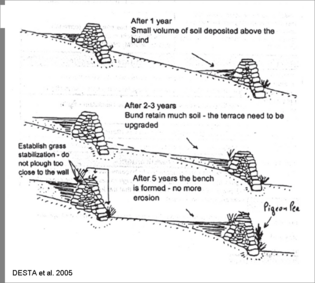
Stone Faced Soil Bunds
- Objectives: The stone faced bunds are reinforced soil bunds in one or both their sides. It has the same objectives of soil and stone bunds. Provided they are well constructed stone faced soil bunds
offer strong resistance against runoff. Stone faced bunds are suitable in areas with high stoniness and stable soils, combined with trenches and vegetative stabilization. Suitable for dry areas and combined with other moisture conservation measures like tie-ridging and compost applications above bund or benched area.
Level Fanya Juu
- Objectives: The FJ reduces and stops the velocity of runoff and consequently reduces soil erosion and the steady decline of crop yields. They are impermeable structures intended to retain rainfall, and hence, increase s.oil moisture, water availability to plants, and increase the efficiency of fertilizer application if any. Fanya juus bench quicker than soil bunds but are not as efficient in moisture conservation and more prone to breakages/overtopping.
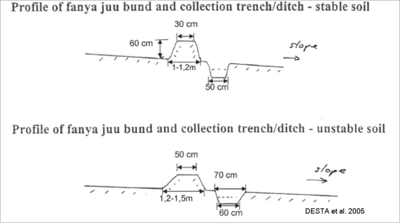
Bench Terracing
- Objectives: The terrace in most cases converts a steep slope into a series of steps, with nearly horizonal benches to reduce velocity of runoff, reduce the soil erosion and the decline in crop yields.
Conservation Tillage using Maresha and Broad Bed and Farrows Maker (BBM)
- Objectives: Undisturbed soil that is permanently protected by vegetative cover improves in the manner that occur in the native ecosystems,including maintenance of porous and soft soil layers through litter accumulation, intense biological activity, movement of soil fauna, and root growth. These functions improve efficient water, heat, and gas transfers within the entire soil profile. The presence of crop residues on the soil surface minimizes soil evaporation, and in regions of low rainfall can conserve water and increase crop water use efficiency thus improving crop yields.
Hillside Terraces
- Objectives: Hillside terraces are physical structures constructed along the contours, generally suitable in steep degraded slopes and shallow soils (although common in other type of soils), suitable for tree planting and rather effective in controlling runoff and erosion. Common in most parts of Ethiopia, generally in dry areas to support area closure plantation and protect downstream fields.
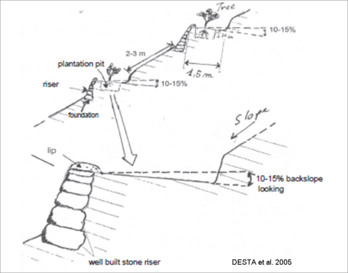
Hillside Terrace with Trenches
- Objectives: HTTs is highly labour intensive - combine both effects of hillsides and trenches constructed immediately above the terrace stone riser, generally suitable for steep slopes (up to 50%) and shallowmedium depth soils (although common in other type of soils). Suitable for tree/shrubs planting and very effective in controlling runoff and erosion. HHTs ensure protection of downstream fields, and play a significant role in replenishing water tables.
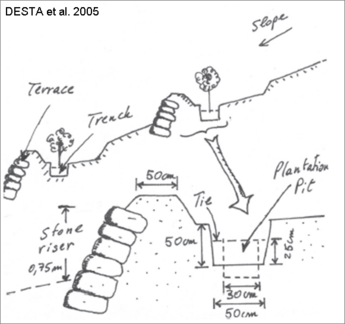
|
Water harvesting[1]
|
Hand-dug Wells
- Objectives: Hand dug wells are used to irrigate small plots or to supply drinking water for human and livestock.
Low cost Water Lifting
- Objectives: They are instrumental in increasing the size of plot and provide the right amount of water to crops at the the right time. The treadle pump, relative to the traditional rope and bucket system will increase irrigated surface areas and reduce irrigation labour time relative to the original irrigated surface area. Thus, resulting in increased production.
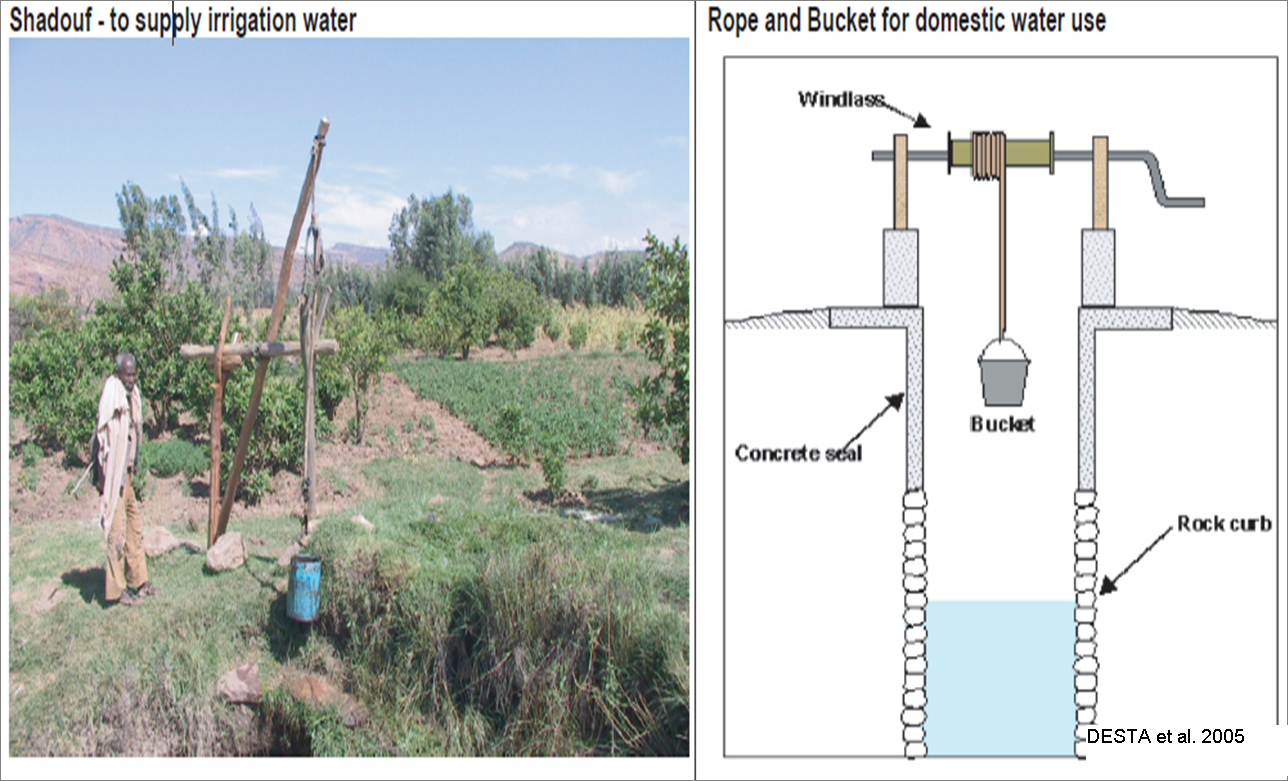
Low Cost Micro-ponds
- Objectives: Supplementary irrigation to high value crops (horticulture, fruit trees, etc.). Water for livestock for a few months. Microponds allow to use surface runoff from small catchment areas within and between homesteads (foot paths, small grazing land areas, rocky areas, etc.). Can also collect water from feeder roads, graded bunds, spillways, etc.). Water collected can be used during the rainy season as supplementary irrigation (during dry spells) or after (1-2 months max) for additional support to horticulture crops, fruit trees, compost, small livestock, beekeeping, etc.
Underground Cisterns
- Objectives: Supplementary irrigation to high value crops (horticulture, fruit rees, small livestock, etc.). Water for livestock for a few months. Water for raising seedlings in dry seasons. Microponds allow to use surface runoff from small catchment areas within and between homesteads (foot paths, small grazing land areas, rocky areas, etc.). Water collected can be used during the rainy season as supplementary irrigation (during dry spells) or after (1-2 months max) for additional support to horticulture crops, fruit trees, compost, small livestock, beekeeping, etc.).
Percolation pit
- Objectives: A percolation pit is a structure, constructed on any marginal land with pervious soil, with the following objectives:
- Recharge the ground water
- Enhance biomass production through improved water availability in the soil profile.
- Reduce runoff and subsequently erosion and land degradation.
Percolation Pond
- Objectives: A percolation pond is a structure, constructed on any marginal land with pervious soil, with the following objectives:
- Recharge the ground water
- Enhance biomass production through improved water availability in the soil profile.
- Reduce runoff and subsequently erosion and land degradation.
Farm Pond Construction
- Objectives: To store surface water for use during dry seasons for the purpose of domestic use, human consumption, irrigation or for fish production.
Spring Development
- Objectives: Proper spring development helps protect the water supply from contamination. The objective of spring development is to collect the flowing underground water to protect it from surface contamination, store it and avail for use.
Family Drip Irrigation System
- Objectives: Increased frequency and uniformity of water application plus reduced competition from weeds results in improved plant growth and yield increases of 30 to 50 percent. The system is instrumental in increasing the size of plot and provide the right amount of water to crops at the the right time. Thus, resulting in increased production.
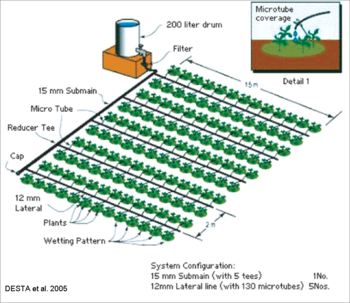
Roof Water Harvesting System
- Objectives: Roof water harvesting is a system for the collection of rainwater for domestic water supply. Roof catchments are used to collect water for individual household use, in schools and other institutions. Gutters and ground storage tanks are required to collect rainwater from roofs; Roof catchements are made of GI sheet and grass tatched materials; It also provides water for livestock, agricultural and fish-farming use.
Farm Dam Construction
- Objectives: Storage farm dams are mainly to store surface runoff water and to use it when required for various uses such as for human and animal consumption, small scale or supplementary irrigation, fish production.
River-bed or Permeable Rack Dams
- Objectives: River bed dams are a floodwater farming techniques where runoff waters are spread in valley bottoms of seasonal riverbeds, large gullies or natural water courses for improved crop and forage producdtion using a long, low structure, made from loose stone (occasionally some gabion baskets may be used). Developing gullies are healed at the same time. Occasionally it is required to raise the riverbed in order to guide spate floods into irrigation canals of spate irrigation schemes, or to accumulate river sediments for riverbed cultivation. In such a case, very strong dams are required that can resist powerful spate floods. It is a relatively low cost structure especially designed to resist heavy flooding. The structures are typically long, low dam walls across valleys. The large amount of work involved means that the technique is labor intensive and needs group approach.
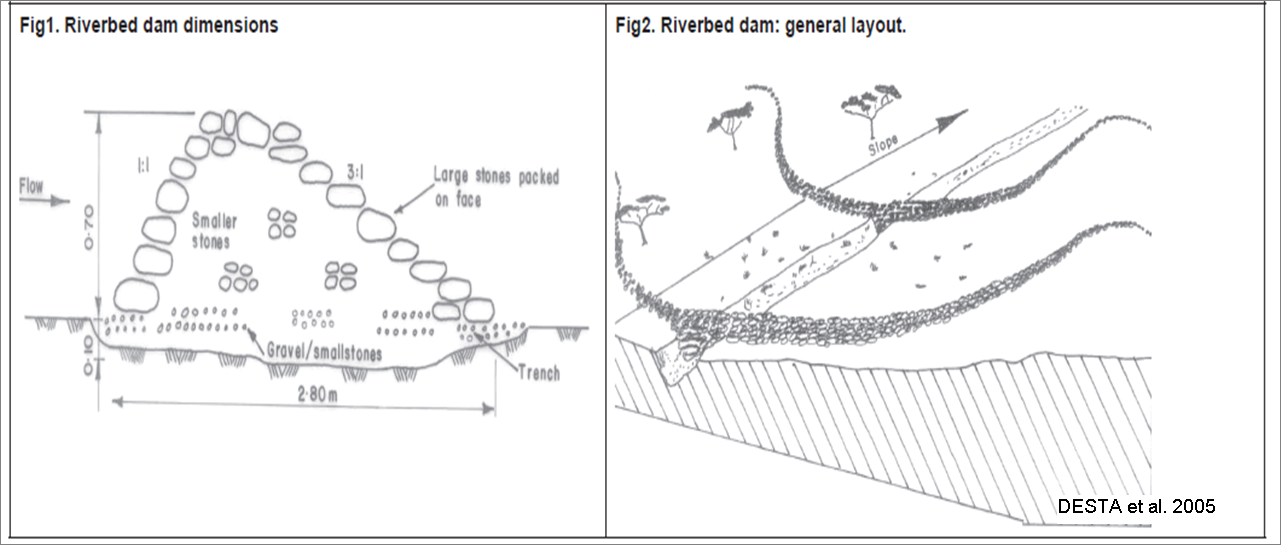
Small Stone Bunds with Run-on and Run-off Areas
- Objectives: The main objective is to considerably increase the biomass production of forage grass and legumes pastures and fodder crops and/or allow the introduction of species having higher water requirements in abandoned, marginal and eroded dry areas. The principle of the system and its application is the same as for runoff/runon systems suggested for the cultivated areas. Rainfall multiplier systems for grazing land can also rehabilite fertility (decay of grass and increased moisture). In this respect, a few years pasture improvement and soil fertility restoration may allow the area to be cropped again. The main difference between this measure and the one described for the cultivated land is that instead of food crops fodder plants are grown. The system is less demanding in terms of size of structures and management of the plots as fodder species require less water than food crops.

Narrow Stone Lines Along the Contour
- Objectives: Stone lines are semi-permeable or permeable structures, intended to capture some moisture and thus allow the growth of spontaneous grass. By slowing down runoff they also decrease erosion, although not completely. This is a soil and moisture conservation measure suitable for rangelands and degraded grazing lands in dry areas. The measure is less labour intensive and material demanding than small stone faced soil bunds but less efficient. The principle is rainfall multiplier system but the measure is applicable only if stones are available.

Stone Faced/Soil or Stone Bunds with Run-off/ Run-on Areas
- Objectives: This is a rainfall multiplier system for reclaiming and rehabilitating marginal areas with low productivity, shallow soils, often affected by surface crusts and low water infiltration rates, with slope ranging between 1 to 5%. Both runoff and runon areas are included within the bunds. The runoff area is intended to serve as a microcatchment to supply additional water into a runon area (cultivated area) to increase production levels in one portion of the total area or to introduce crops with higher water requirements that otherwise would not grow without additional moisture.
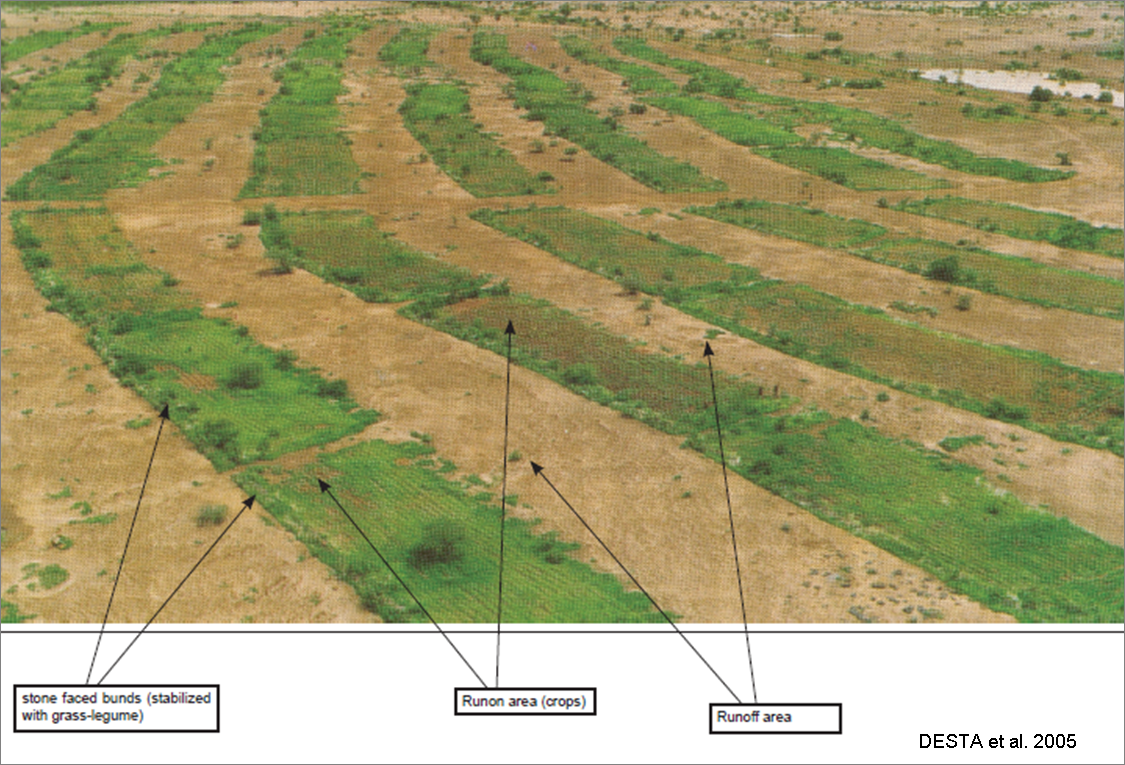
Conservation Bench Terraces (s) (CBT(s))
- Objectives: CBTs are constructed on steep slopes to combine soil and water conservation with water harvesting practices. They control erosion and retain moisture and are suitable for food/ tree crops and are effective in controlling runoff and erosion. They are also water harvesting structures, the riser acts as a catchment. Common in most parts of Ethiopia, (e.g Konso) generally in dry areas. Benching action eases cultivation operation by oxen, however, more appropriate to use.

Tie Ridge (s)
- Objectives: Tie ridges are small rectangular series of basins formed withing the furrow of cultivated fields mainly to increase surface storage and to allow more time for rainfall to infiltrate the soil. Making tied ridges manually is time and labor consuming.

The Zai and Planting Pit System
- Objectives: Zai pits are systems of small pits dug along approximate contours allows the cultivation of crops on degraded lands. The zaï pits restore degraded lands (crusted, hard, compacted and poorly structured soils), thus increasing the land available for cultivation. It is a simple technique that, amongst others, landless or oxenless can practice because it requires only manual labour.
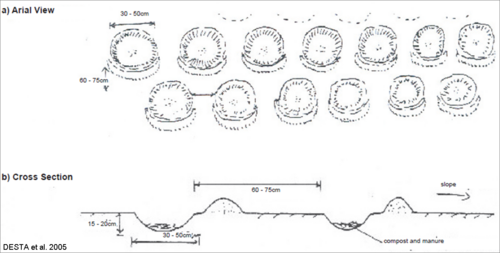
Large Half Moons
- Objectives: The measure is a rainfall multiplier system that allow cultivation of crops in low rainfall areas. It is applied in areas with sandy and sandy loamy soils affected by low fertility levels and thin surface crusts that inhibit infiltration and increase runoff. Large half moons are suitable structures to enable cultivation of drought resistant crops in areas with very low rainfall. They intercept all runoff and stop erosion. It is also a measure suitable for rangelands and degraded grazing lands in dry areas (forage crops).
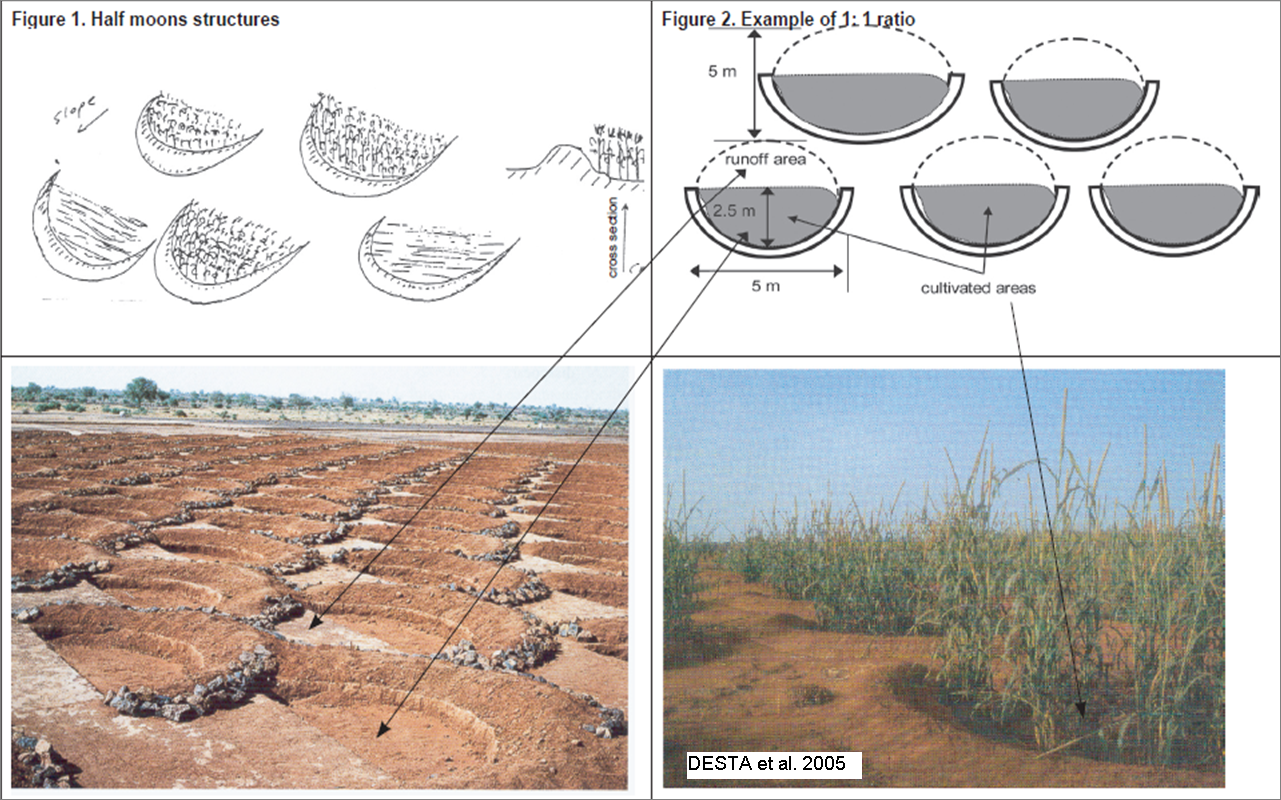
Division Weir Design and Construction
- Objectives: To divert stream flow for use during dry seasons for the purpose of small scale irrigation and for any other supplementary irrigation.
For more information see http://agriwaterpedia.info/wiki/Water_Harvesting
|
|
|
|
|
Income generating measures
|
|
|
|
|


